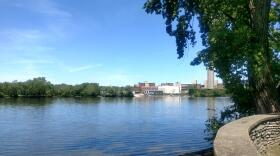The U.S. Environmental Protection Agency has reached an agreement with General Electric to study PCB contamination in the Lower Hudson. EPA officials updated members of the Hudson River Community Advisory Group about the plan of action on Wednesday.
Monitoring continues years after GE completed dredging of PCB-contaminated sediment on the upper Hudson.
But a new agreement reached between the company and government agency announced this week will expand the scope of study to the lower Hudson between Troy and Manhattan.
EPA Hudson River Field Office Director Gary Klawinski was among officials from the agency that provided an update over Zoom Wednesday afternoon.
“We went over the scopes with them, we explained to them what we wanted, when we wanted it, and so we entered this agreement with them for two to three years’ worth of data collection: data, fish, sediment,” said Klawinski.
Speaking to members of the Hudson River Community Advisory Group, Klawinski said the data collection is envisioned to take place through 2024. But the question of whether GE will undertake a cleanup effort similar to the northern Hudson’s dredging effort is not being considered at this time.
“As we collect all that information we’ll decide what’s next, what’s the next thing to do after we collect that,” said Klawinski.
The primary focus of the study will be PCB’s, but Klawinski said GE has also agreed to cooperate with EPA to investigate other contaminants that may be detected, as the agency seeks to determine what’s there and who is responsible for it.
Other agencies, including the New York State Department of Environmental Conservation, have already been sampling the lower Hudson.
In a statement, DEC Commissioner Basil Seggos said the new data “will supplement the extensive sampling efforts previously conducted by DEC, EPA, and GE to evaluate the health of one of New York’s most important waterbodies. New York State DEC looks forward to continuing to work with EPA to understand what further actions can be taken to address unacceptable levels of contamination that remain in the river.”
Former DEC Geologist Kevin Ferrar, who now works with environmental group Scenic Hudson, was among attendees questioning the EPA Wednesday. Among its goals, Scenic Hudson is seeking a full damage assessment of contaminants in the river.
Ferrar asked Klawinsky if the upcoming data collection will lead EPA to decide whether to undertake a next step, a Superfund Remedial Investigation/Feasibility Study – or RI/FS.
“Do you think it’s more along the lines of whether or not you’re going to do the RI/FS, or when you’re ready to develop the initial scope of the RI/FS?”
“We haven’t decided to do an RI/FS, or decided not to do an RI/FS. We’re not in a poisiton to discuss that yet,” said Klawinsky.
“OK. Do you think it’s possible that there’s data out there that would lead EPA to the conclusion that you don’t need to do an RI/FS? I mean, we have a long history of fish data in the lower river. And we know that the health – both human health and ecological risk levels – are well in excess of your risk tolerance ranges. What would it take for you to decide that you would not need to do an RI/FS?”
“I’m not prepared to draw that…I don’t really want to speak in the negative. I’d rather speak in the positive as to…just going back to what I said before. We have multiple things to do. It’s not just data collection. EPA has due diligence work to also do in parallel with this. So we’re expecting things to come together as things move forward. What we’re happy about is we have a cooperating party that is going to get out on the river under our oversight and get data quickly,” said Klawinsky.
As GE prepares to sample fish, sediment and water at various locations along the lower Hudson, CAG member David Mathis, an avid boater and retired Saratoga town judge, asked EPA to consider sampling high-use areas.
“You may have to go to local communities and check and maybe do a survey in schools and say, ‘Where do you guys swim? You jumping off a wall someplace? You wading around?’ That’s what we need to protect the public. Yes, we need to protect the fish so people don’t ingest the PCBs, but we need to identify those areas where they’re coming in contact with them in the sediment,” said Mathis.
“Yeah, thank you for that. That’s something we’ll take into consideration as we go forward,” said Klawinksy. “I think many of those areas you described have probably already been sampled and there’s New York State data there, but we’ll go back and we can do some checking.”
EPA says it will “look to engage with communities along the lower Hudson, including communities that have environmental justice concerns.”
A GE spokesman provided a statement to WAMC:
"Following years of close coordination with EPA in the cleanup of the Upper Hudson River, GE is voluntarily working with EPA to collect environmental data on the Lower Hudson. This will enable more learning about environmental conditions and multiple sources of industrial and municipal contamination in the 150 miles of the Hudson south of Albany, N.Y. GE will collect this data under EPA’s authority."





